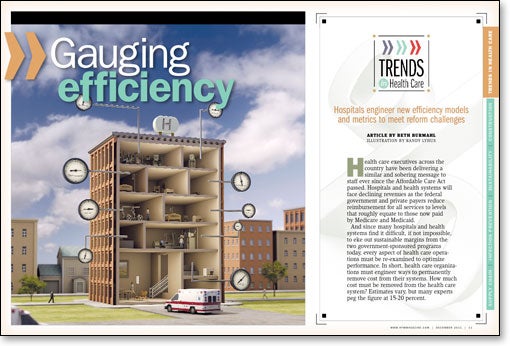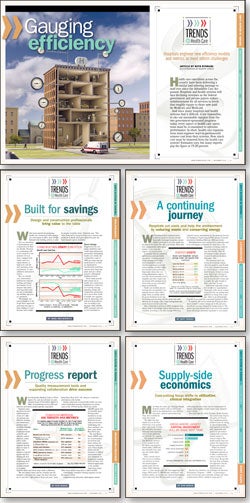Gauging efficiency

Health care executives across the country have been delivering a similar and sobering message to staff ever since the Affordable Care Act passed. Hospitals and health systems will face declining revenues as the federal government and private payers reduce reimbursement for all services to levels that roughly equate to those now paid by Medicare and Medicaid.
And since many hospitals and health systems find it difficult, if not impossible, to eke out sustainable margins from the two government-sponsored programs today, every aspect of health care operations must be re-examined to optimize performance. In short, health care organizations must engineer ways to permanently remove cost from their systems. How much cost must be removed from the health care system? Estimates vary, but many experts peg the figure at 15-20 percent.
With this as a backdrop, managers navigating the turbulent economic waters of today's health care climate are advised to follow one basic survival strategy: If you're not generating revenue, you had better be reducing hospital expenses and finding more efficient ways to deliver services. And if you fall into this latter category of staff, you need to document performance-improvement results and cost savings.
The good news is that health care facilities are getting better not only at implementing effective efficiency plans, but in developing new and often creative methods to cut costs, maximize performance and track progress.
Along with smarter, leaner and greener waste reduction and energy plans, hospitals are tightening operational control strategies, using innovative design techniques like simulation modeling and redesigning departments to reduce silos and expand shared services and facilities. At the same time, they're reengineering supply chain operations, focusing on utilization data to partner with physicians on reducing variation in medical device usage and other product consumption areas to continuously reduce costs.
But implementing successful efficiency strategies doesn't happen in a vacuum. Collaboration increasingly is critical to cost-cutting, according to hospital engineers, environmental services professionals, infection control specialists, architects and construction managers, and supply chain leaders who say working in concert is the best way to maximize the resources and talents of one of a facility's greatest assets: people.
"A facility manager's engineering training, rigor and discipline is perfectly suited for process mapping and gap analysis," says Dale Woodin, CHFM, FASHE, executive director of the American Society for Healthcare Engineering (ASHE). "But this starts with taking the time to understand your organizational goals and challenges and openly seeking inclusion on one or more teams."
Targeting 'sacred cows'
As cash-strapped facilities face mounting pressure to improve quality and safety, many are postponing capital projects in favor of operational efficiencies that extend to areas long considered "sacred cows," says Woodin.
More facilities are reinvesting in infrastructure by replacing older boilers, chillers and air handlers with more efficient units and increasing spending on control systems to achieve tighter operational parameters.
Hospitals also are implementing operating room (OR) setbacks, an energy-saving strategy that reduces the amount of air supplied to an OR when not in use. ASHE recently published research on OR setbacks, providing tools and challenging facility managers to reduce their cooling load in surgical areas, says Woodin.
"I have heard from a number of facility managers who have done just that —reduced operating costs with no reduction in patient care or infection prevention," says Woodin.
As regulations tighten, more facilities are turning to displacement ventilation, which offers the possibility of saving energy while maintaining or improving patient and staff safety by supplying clean, fresh air directly into the occupied area at low level, at the correct temperature, says Walt Vernon, president of Mazzetti Nash Lipsey Burch (M+NLB), a mechanical, electrical, plumbing and technology engineering and environmental performance consulting and design firm headquartered in San Francisco.
"The energy-saving technique is a better option for patients and waiting rooms," says Vernon.
Designers streamline operations
Capital projects that are underway tie directly into the efficiency and sustainability movement, experts say.
 There is a shift toward freestanding ambulatory centers with an emergency and critical care component, reversing the current model. "This eliminates many of the fixed services hospitals carry with them and creates a leaner, simpler model to operate," says Hamilton.
There is a shift toward freestanding ambulatory centers with an emergency and critical care component, reversing the current model. "This eliminates many of the fixed services hospitals carry with them and creates a leaner, simpler model to operate," says Hamilton.
To speed construction and reduce cost, Joe Sprague, FAIA, FACHA, FHFI, principal and senior vice president at HKS Inc. in Dallas, is using prefabricated modular components for exterior walls and panels that are built off-site and trucked to the facility. The components have huge potential, he says.
"We're also using them for what is considered the engineering side — headwalls, toilet details," says Sprague. "We're even looking at prefabricating the ducts and the conduit in mechanical systems."
Designwise, facilities continue to seek firms with evidence-based design credentials, partly as a strategy for reducing errors and infection rates, says Kirk Hamilton, FAIA, FACHA, EDAC, a professor of architecture at Texas A&M University.
Although data doesn't yet support the theory, standardized, same-handed patient rooms are starting to gain traction as an error-reduction technique, Hamilton says. "A lot of people are betting real money and making major capital decisions on this hypothesis."
Sprague says functionality continues to drive design and that collaborating with clinical staff who "basically teach designers how to be savvy about operation issues" becomes more critical. Using simulation modeling to develop smart, cost-effective workflow plans also is becoming more common, says Sprague.
Hospitals striving to stay Lean also are decentralizing nurses' stations, consolidating departments and sharing services. "Instead of having seven departments, seven receptionists and seven waiting rooms, you create one department operating as a more efficient model," says Hamilton.
"The savvy manager will look for opportunities to add value, by stepping up to fill the gaps and taking on additional responsibilities," says Patti Costello, executive director of the Association for the Healthcare Environment.
But efficiency can be in the eye of the beholder. Because consolidation often means staffing cuts, some managers say efficiency actually decreases along with staffing levels.
"Unfortunately, we are seeing very deep staffing cuts in environmental services, which means something's going to suffer," says Costello. "Unless you establish very clear environmental cleaning standards with the executive team in advance, you may see a marked decrease in cleanliness and patient satisfaction. Because the uncertainty of this environment will be around for a while, managers have to find creative ways to make Lean and mean work for them."
Rather than cutting front-line staff where the return is marginal, Costello suggests investing in positions that will pay off significantly down the road — people with expertise in finding cost savings in the waste stream. "Those positions will more than pay for themselves," she says.
Save water, save energy
Although Costello stresses that "trash is still cash," and hospitals are making great strides in waste reduction, Vernon says facilities increasingly are targeting another area ripe for conservation: water.
"We're seeing the energy-water nexus as the next broad trend for an obvious reason: When you save energy, you save water and vice versa," says Vernon. "It is amazing how much water goes to electricity and how much energy is used to pump and treat wastewater."
Facilities that undergo water audits with M+NLB often are astonished by the level of waste as well as the tremendous opportunity for improvement, says Laura Brannen, senior environmental performance consultant at the firm. "For example, most walk-in fridges and ice machines use once-through domestic cold water for cooling. No-process water should be used only once," says Brannen. "This is representative of a large majority of hospitals. With water being such a precious resource, we can do much better."
Elsewhere, facilities continue to raise the bar in their quest to erase their carbon footprints. One example: In 2010, the Memorial Hermann Healthcare System in Houston achieved $12 million in aggregate energy savings in 14 hospitals. Within the system, three hospitals earned the Environmental Protection Agency's (EPA's) Energy Star designation and 11 were recognized by ASHE's Energy Efficiency Commitment (E2C), which encourages hospitals to reduce energy consumption by 10 percent or more in support of the EPA challenge.
"Through strong organizational leadership and individual commitment at each facility, the dollars that would have been spent on utility bills went to supporting their mission of patient care," says Woodin.
Tapping the supply chain
Materials managers are taking a similar tack in partnering with physicians on ways to reduce what is typically the largest nonlabor component of hospital spending — supplies.
This dialog has expanded far beyond standardization of such physician-preference products as orthopedic, spine and other expensive medical devices with the aim of leveraging better vendor pricing. Today, increasingly, the focal point in physician engagement is product utilization trends to assess which providers are most efficient in their total cost of care delivery while maintaining high quality.
Scott Downing, executive vice president of sales and marketing for VHA Inc., Irving, Texas, says this level of scrutiny eventually will permeate organizations to cover all areas of care delivered within and outside the hospital walls. He says the rapidly emerging impact of clinical integration will call for a different set of business analytics to support processes.
"The conversation [going forward] will not necessarily be about the widget, but the use of the widget and the quality impact of the widget on the process of care, and that's just not how the supply chain has operated," Downing says.
'Data are king'
As important as efficiency measures are to any facility's future, documenting performance gains and operational savings and sharing successes with superiors is equally critical. "Performance improvement metrics — and data — are king and will be for the foreseeable future," says Woodin.
But while cost reduction and operational efficiency are often part of a facility manager's DNA, self-promotion often is not, says Woodin. Nevertheless, facility professionals need to make that practice part of their job descriptions.
"In my experience, facility managers who are recognized by senior leadership, and often promoted, are those who clearly state cost-saving goals and document their achievement of these goals in writing," says Woodin. "They regularly brief senior leaders and bake these performance metrics into their own performance review process."
Equally important is staying focused on the shared goals that don't shift with the trends. "No matter how tough this environment gets, environmental professionals are committed to patient satisfaction and quality outcomes," says Costello. "That never changes."
Beth Burmahl is an Oak Park, Ill.-based freelance writer with an extensive background in the health care industry.




